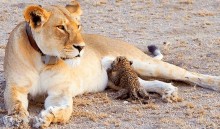Private guides and guided tours in Namibia

Namibia
Language: English
Currency: Namibian dollar
Calling Code: +264
CAPITAL CITY OF Namibia: Windhoek
LANGUAGE OF Namibia: English
CURRENCY OF Namibia: Namibian dollar
COMMENTS ABOUT Namibia:
Namibia, officially the Republic of Namibia, is a country in southern Africa on the Atlantic coast. Namibia generally attracts eco-tourists with the majority visiting to experience the different climates and natural geographical landscapes such as the great eastern desert and plains. There are many lodges and reserves for eco-tourists to travel to and stay over.
Cities : Windhoek (capital), Keetmanshoop, Lüderitz, Ondangwa, Oshakati, Swakopmund, Tsumeb, Tsumkwe, Walvis Bay
Best Places : Namibian canyon, Twyfelfontein in Namib Desert, Brandberg Mountains, Etosha National Park, Kolmanskop, Waterberg Plateau Park, Sossusvlei, Skeleton Coast, Spitzkoppe, Fish River Canyon, Opuwo & Kaokoland
Calling Code : +264
Time Zone : UTC +1
South Africa occupied the German colony of South-West Africa during World War I and administered it as a mandate until after World War II, when it annexed the territory. In 1966 the Marxist South-West Africa People's Organization (SWAPO) guerrilla group launched a war of independence for the area that was soon named Namibia, but it was not until 1988 that South Africa agreed to end its administration in accordance with a UN peace plan for the entire region. Namibia won its independence in 1990 and has been governed by SWAPO since. Hifikepunye POHAMBA was elected president in November 2004 in a landslide victory replacing Sam NUJOMA who led the country during its first 14 years of self rule.
CLIMATE OF Namibia: desert; hot, dry; rainfall sparse and erratic
RELIGION OF Namibia: Christian 80% to 90% (Lutheran 50% at least), indigenous beliefs 10% to 20%
POPULATION OF Namibia: 1,954,033 black 87.5%, white 6%, mixed 6.5% note: about 50% of the population belong to the Ovambo tribe and 9% to the Kavangos tribe; other ethnic groups are: Herero 7%, Damara 7%, Nama 5%, Caprivian 4%, Bushmen 3%, Baster 2%, Tswana 0.5%>>
HISTORY OF Namibia: South Africa occupied the German colony of South-West Africa during World War I and administered it as a mandate until after World War II, when it annexed the territory. In 1966 the Marxist South-West Africa People's Organization (SWAPO) guerrilla group launched a war of independence for the area that was soon named Namibia, but it was not until 1988 that South Africa agreed to end its administration in accordance with a UN peace plan for the entire region. Independence came in 1990 following multi-party elections and the establishment of a constitution. President NUJOMA is currently serving his third term as president.
ECONOMY OVERVIEW OF Namibia: The economy is heavily dependent on the extraction and processing of minerals for export. Mining accounts for 20% of GDP. Rich alluvial diamond deposits make Namibia a primary source for gem-quality diamonds. Namibia is the fourth-largest exporter of nonfuel minerals in Africa, the world's fifth-largest producer of uranium, and the producer of large quantities of lead, zinc, tin, silver, and tungsten. The mining sector employs only about 3% of the population while about half of the population depends on subsistence agriculture for its livelihood. Namibia normally imports about 50% of its cereal requirements; in drought years food shortages are a major problem in rural areas. A high per capita GDP, relative to the region, hides the great inequality of income distribution; nearly one-third of Namibians had annual incomes of less than $1,400 in constant 1994 dollars, according to a 1993 study. The Namibian economy is closely linked to South Africa with the Namibian dollar pegged to the South African rand. Privatization of several enterprises in coming years may stimulate long-run foreign investment. Mining of zinc, copper, and silver and increased fish production led growth in 2003.



 French
French Spanish
Spanish Russian
Russian